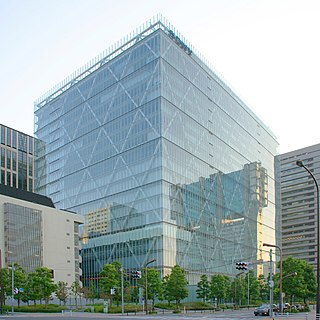The Rewriteable Consumer Timecode (RCTC, RC Timecode, or RC Time Code) is a nearly frame accurate timecode method developed by Sony for 8mm and Hi8 analog tape formats. [1] The RC timecode is written by the video camera directly to analog tape tracks and records the hour, minute, second and frame for each frame of video recorded to tape. Officially, RCTC is accurate to within ±2 to 5 frames. [2] The RC timecode information is written in a separate area of the track so as to not disturb the audio or video information recorded on the tape. The RC timecode was used in conjunction with the datacode to record date, time and frame information directly to the 8mm tape tracks.
A timecode is a sequence of numeric codes generated at regular intervals by a timing synchronization system. Timecode is used in video production, show control and other application which require temporal coordination or logging of recording or actions.

Sony Corporation is a Japanese multinational conglomerate corporation headquartered in Kōnan, Minato, Tokyo. Its diversified business includes consumer and professional electronics, gaming, entertainment and financial services. The company owns the largest music entertainment business in the world, the largest video game console business and one of the largest video game publishing businesses, and is one of the leading manufacturers of electronic products for the consumer and professional markets, and a leading player in the film and television entertainment industry. Sony was ranked 97th on the 2018 Fortune Global 500 list.
On several video camera models, Sony included the ability to search by date/time (appropriately called Date Search) and to index positions within the tape so that the index mark could be returned to with the press of a button. [1]
The RC timecode is a different technology than the SMPTE timecode, linear timecode (LTC), and vertical interval timecode (VITC).
SMPTE timecode is a set of cooperating standards to label individual frames of video or film with a timecode. The system is defined by the Society of Motion Picture and Television Engineers in the SMPTE 12M specification. SMPTE revised the standard in 2008, turning it into a two-part document: SMPTE 12M-1 and SMPTE 12M-2, including new explanations and clarifications.
Linear Timecode (LTC) is an encoding of SMPTE timecode data in an audio signal, as defined in SMPTE 12M specification. The audio signal is commonly recorded on a VTR track or other storage media. The bits are encoded using the biphase mark code : a 0 bit has a single transition at the start of the bit period. A 1 bit has two transitions, at the beginning and middle of the period. This encoding is self-clocking. Each frame is terminated by a 'sync word' which has a special predefined sync relationship with any video or film content.
Vertical Interval Timecode is a form of SMPTE timecode encoded on one scan line in a video signal. These lines are typically inserted into the vertical blanking interval of the video signal.
At least one manufacturer (Octochron [3] ) created tools to capture the information from the RC timecode on tape and export it via Serial or USB to the computer.
A partial list of camcorders which supported RC timecode. [4]
| NTSC Camcorder Models with RC Timecode |
|---|
| Sony CCD-SC55 |
| Sony CCD-TR101 |
| Sony CCD-TR2300 |
| Sony CCD-TR3000 |
| Sony CCD-TR3300 |
| Sony CCD-TR3400 |
| Sony CCD-TR555 |
| Sony CCD-TR700 |
| Sony CCD-TR910 |
| Sony CCD-TRV101 |
| Sony CCD-TRV81 |
| Sony CCD-TRV99 |
| Sony CCD-V801 |
| Sony CCD-VX3 |
| PAL Camcorder Models with RC Timecode |
|---|
| Sony CCD-SC55E |
| Sony CCD-TR2200E |
| Sony CCD-TR2300E |
| Sony CCD-TR3100E |
| Sony CCD-TR3200E |
| Sony CCD-TR3300E |
| Sony CCD-TR3400E |
| Sony CCD-TR555E |
| Sony CCD-TR825E |
| Sony CCD-TR845E |
| Sony CCD-TRV69E |
| Sony CCD-TRV77E |









